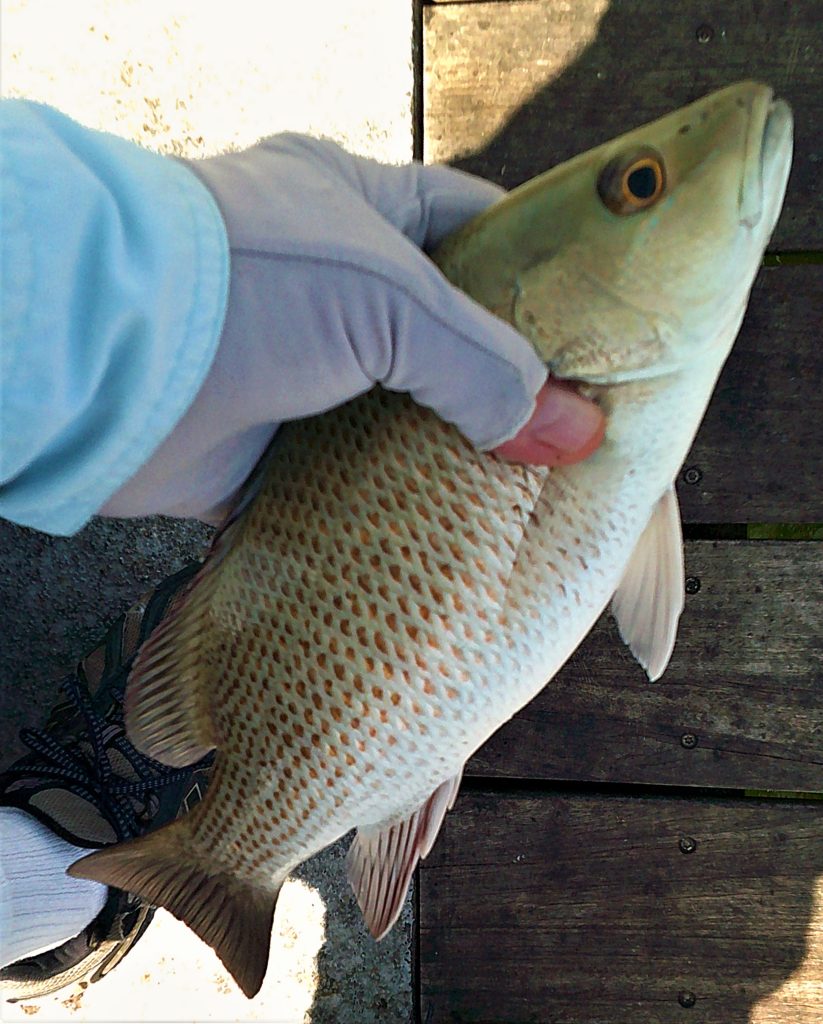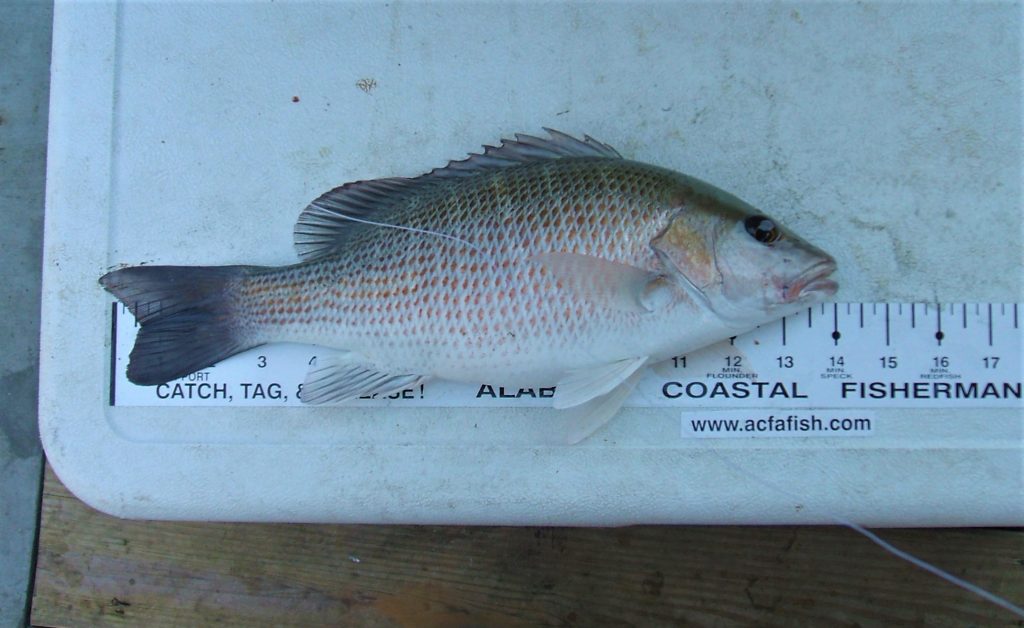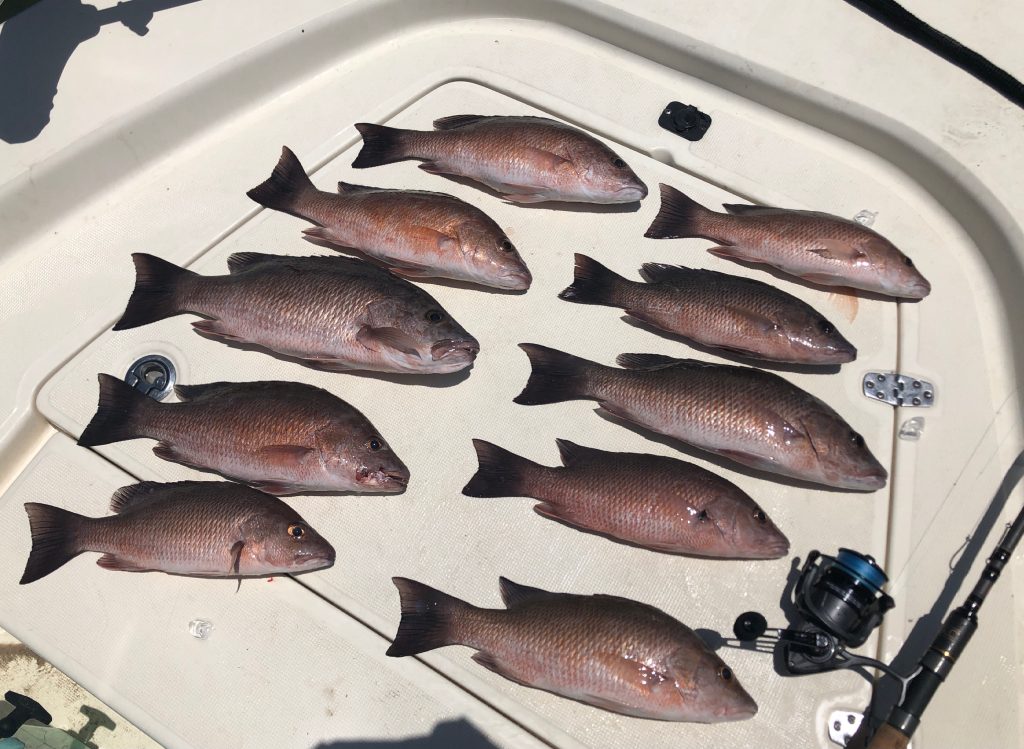Mangrove snapper may not be the most glamorous fish species along the Emerald Coast, but they certainly are the most diverse member of the snapper family. Though widely distributed and often encountered by inshore anglers, mangroves are commonly misidentified by rookie fishermen. Mainly because new fishermen may not expect to catch snapper of any species from shore, near shore, and especially inshore. Plus, Mangrove snapper (Lutjanus griseus in Latin) are also known by so many other names depending on the location and color phase of the fish.
At times they are called Grey, Gray, or Black snapper, Mango, Mingo, and several other names simply because the angler just isn’t quite certain what they are dealing with. The color phases of Mangrove snapper vary from a light gray base with darker brown spots on the sides in clear Gulf waters, to dark reddish brown overall when caught in brackish or tannin inshore waters. Mangroves usually exhibit a characteristic dark stripe that runs diagonally through the eye, and have two distinctive large canine teeth in the upper jaw with which they grab and hold prey.
Cubera Snapper vs Mangrove Snapper
Mangroves are often confused with young Cubera snapper which are similarly shaped, but a Cubera snapper has more large teeth on the top and bottom jaws. The shape of the “tooth patch” inside the mouth is another tip off as to the species. Dog snapper are most often confused with Mangroves, but have a light colored triangle under each eye as well as a bright blue stripe. They also have more teeth in the upper and lower jaw than mangroves do.

Mangrove Snapper World Record
The World record Grey Snapper (Mangrove) was caught out of Cocodrie, LA and weighed in at 18 pounds 10 ounces. Mangrove snapper grow to about 15 to 18 pounds, while most of the other snapper species, including the more popular Red snapper may grow to over 40 pounds. Spawning for Mangrove snapper usually takes place (offshore) around the full moons of July and August. Characteristically, mangroves use brackish water estuaries as nurseries, and grow rather quickly the first couple of years until they near adulthood. These pre adult fish orient to any hard structures near the mouth of estuaries, feeding heavily on invertebrates and small fish. This habit is why so many shorebound anglers encounter undersized Mangrove snapper around piers, jetties and seawalls. Their relative abundance is because they stage around these heavily fished locations before entering the adult population offshore. Only rarely are Mangrove snapper longer than 14 to 16 inches found inshore, and even rarer are fish less than that size found offshore.
How To Catch Mangrove Snapper
All this makes targeting Mangrove snapper a fairly selective fishery. Though they are often incidentally caught by anglers intent on other species. This is especially true in estuaries with Gulf access to jetties, bridges, docks and piers like those found through the back bays of Mississippi, Alabama, and the Florida Panhandle.
Anglers fishing these locations, and even farther upstream, often have their live shrimp or even lures (intended for speckled trout, redfish, or flounder) intercepted by juvenile Mangrove snapper. Though fun to catch, the vast majority of these fish are well below the minimum size limit. That is 12 inch Total Length (TL) in Federal waters, in Mississippi, and in Alabama. Additionally, Alabama requires a $10 Gulf Reef Fish Endorsement License to retain Mangrove snapper, even if the fish (legal sized) are caught from land or inland. Florida has a 10 inch TL, with a daily bag of 5. While bag limits in Federal waters, Mississippi and Alabama are 10 per angler per day. So be sure to know your regulations or have an app.
Still, inshore or from shore anglers may “luck” into mangroves occasionally. Especially when fishing at night, like what happened to video creator, Justin Reed last fall. He was fishing near nightfall to after dark, from the beach along the Florida Panhandle with his buddy Brian Demo. Justin recounted “We threw out Fishbites and frozen shrimp at various distances. Once it got dark, Brian’s rod about 30 yards from shore went off. We thought it was just a whiting, but when we got it close enough to see, we realized it was a Mangrove snapper. We couldn’t believe it! After the excitement we measured the fish, and it was a keeper. Shortly after that my rod that was also about 30 yards from shore went off. I ran down the beach to grab it and reel it in, and it was another Mangrove snapper! We again got really excited because it is not a common catch from the beach. My fish was also a keeper. Catching not one, but two (keeper) Mangrove snapper from the beach is an experience we both will remember for a long time.”

The fishery for most legal-sized Mangrove snapper takes place in the near shore and offshore coastal waters from 50 feet deep out to over 120 feet deep according to Stephen Franklin of Orange Beach Alabama. This young man is an Army veteran, as well as a certified Boat Captain, Fishing Guide, and video content creator. Posting as “Bama Saltwater” on Facebook and YouTube, he has over 117,000 subscribers. “Yeah, it’s not easy to catch a ‘legal’ Mangrove from the seawall, jetty, or Gulf pier. But once you move out 5 to 20 miles or so, you can find some nice ones,” Franklin said with a chuckle.
The Captain continued. “I like either of two methods, depending on the conditions and time of year, when and where they are available.” Then he added, “The gas rigs off the Alabama coast in 50 to 60 feet of water are ideal. I usually find Mangrove snapper suspended about six to eight feet deep around the structure. These are two to six pound fish that just love live shrimp.”
Chumming is the method Franklin prefers over deeper, larger reefs, in water ranging from 60 to 110 feet. “These larger reefs seem to have more Mangrove snapper on them than the pyramid reefs.” He said, “They respond well to chumming with cut sardines or cigar minnows which sink, drawing the fish up. Sometimes you can even sight fish them with a light ‘Knocker rig’. When strong currents or winds are prevailing, Franklin prefers a light double drop “chicken rig” or “pompano rig” with a bank sinker. The bait is cut cigar minnows or ballyhoo, which is his favorite. Franklin ended with, “Just bury the hook in the bait with only the point exposed a little. Because Mangrove snapper have very good eyesight.”
Mangrove Snapper Rig
Franklin’s tackle of choice is a medium to medium heavy class spinning combo. “Trout tackle”, with a 7 to 7 ½ foot rod and a 4000 size reel with 20 pound line. The terminal tackle is a Carolina rig, with just enough weight (egg sinker) to control the drop, depending on the amount of wind and current present. The leader is about three feet of 20# fluorocarbon and a 2/0 Mustad circle hook. “That size is about a 1/0 size circle hook in other brands,” he noted.
Best Bait For Mangrove Snapper
“Then just hook the shrimp under the horn on its head and toss it toward the structure, letting it slowly sink to the fish.” Franklin added, “Sometimes, I use a slip cork presentation to keep the bait in position and indicate a strike. This works best when the wind and current are fairly light.” He also mentioned, “The bite is usually pretty ‘clean’ for Mangrove snapper with these methods. And fishing deeper just produces more bycatch, like Red snapper.”

How To Cook Mangrove Snapper
The typical size of Mangrove snapper, at two to less than 10 pounds makes their flesh sweeter with better texture than larger, courser fleshed Red snapper. They are ideal for a variety of preparations from frying to pan-sauteing in the smaller sizes. Fillets from 12” to 15” mangroves taste wonderful when pan-sauteed whole in just a little olive oil with a dash of seasoning. Many prefer Cavender’s Greek Seasonings for its distinctly delicate Mediterranean flavor. Mangroves larger than 15 inches should probably be cut into smaller pieces to bake, fry, or pan-saute.
But from about 20 inches or longer, Mangrove snapper are ideal candidates to grill on the half-shell. This simple yet delicious recipe starts with skin attached, whole fillets that have been rinsed and deboned. Larger fillets, more than an inch thick may be scored several times on the flesh side to allow more even cooking.
Get your grill hot (above 450°), and place the fillets on it with the scale side down. Pour an even coating of your favorite Italian dressing over the flesh and lower the grill hood. Reduce the heat to “low”, but check after 15-20 minutes. Raise the heat some if the fillets are not “browning” on top as the oil in the dressing cooks off. Apply a little more dressing to any areas which have dried out or look “burnt”. The fish should be cooked all the way through in 20-25 minutes per inch of thickness. Use a wide spatula to remove the whole fillet, or separate the cooked fish from the skin and place on the plate to serve while still hot.




